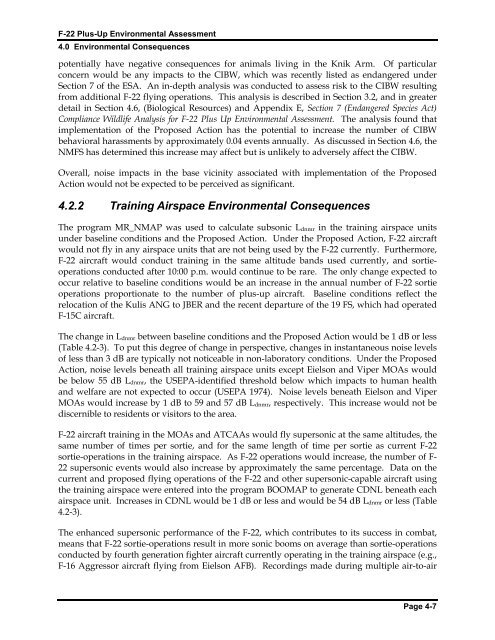F-22 Plus-Up Environmental Assessment - Joint Base Elmendorf ...
F-22 Plus-Up Environmental Assessment - Joint Base Elmendorf ...
F-22 Plus-Up Environmental Assessment - Joint Base Elmendorf ...
Create successful ePaper yourself
Turn your PDF publications into a flip-book with our unique Google optimized e-Paper software.
F-<strong>22</strong> <strong>Plus</strong>-<strong>Up</strong> <strong>Environmental</strong> <strong>Assessment</strong><br />
4.0 <strong>Environmental</strong> Consequences<br />
potentially have negative consequences for animals living in the Knik Arm. Of particular<br />
concern would be any impacts to the CIBW, which was recently listed as endangered under<br />
Section 7 of the ESA. An in-depth analysis was conducted to assess risk to the CIBW resulting<br />
from additional F-<strong>22</strong> flying operations. This analysis is described in Section 3.2, and in greater<br />
detail in Section 4.6, (Biological Resources) and Appendix E, Section 7 (Endangered Species Act)<br />
Compliance Wildlife Analysis for F-<strong>22</strong> <strong>Plus</strong> <strong>Up</strong> <strong>Environmental</strong> <strong>Assessment</strong>. The analysis found that<br />
implementation of the Proposed Action has the potential to increase the number of CIBW<br />
behavioral harassments by approximately 0.04 events annually. As discussed in Section 4.6, the<br />
NMFS has determined this increase may affect but is unlikely to adversely affect the CIBW.<br />
Overall, noise impacts in the base vicinity associated with implementation of the Proposed<br />
Action would not be expected to be perceived as significant.<br />
4.2.2 Training Airspace <strong>Environmental</strong> Consequences<br />
The program MR_NMAP was used to calculate subsonic L dnmr in the training airspace units<br />
under baseline conditions and the Proposed Action. Under the Proposed Action, F-<strong>22</strong> aircraft<br />
would not fly in any airspace units that are not being used by the F-<strong>22</strong> currently. Furthermore,<br />
F-<strong>22</strong> aircraft would conduct training in the same altitude bands used currently, and sortieoperations<br />
conducted after 10:00 p.m. would continue to be rare. The only change expected to<br />
occur relative to baseline conditions would be an increase in the annual number of F-<strong>22</strong> sortie<br />
operations proportionate to the number of plus-up aircraft. <strong>Base</strong>line conditions reflect the<br />
relocation of the Kulis ANG to JBER and the recent departure of the 19 FS, which had operated<br />
F-15C aircraft.<br />
The change in L dnmr between baseline conditions and the Proposed Action would be 1 dB or less<br />
(Table 4.2-3). To put this degree of change in perspective, changes in instantaneous noise levels<br />
of less than 3 dB are typically not noticeable in non-laboratory conditions. Under the Proposed<br />
Action, noise levels beneath all training airspace units except Eielson and Viper MOAs would<br />
be below 55 dB L dnmr, the USEPA-identified threshold below which impacts to human health<br />
and welfare are not expected to occur (USEPA 1974). Noise levels beneath Eielson and Viper<br />
MOAs would increase by 1 dB to 59 and 57 dB L dnmr, respectively. This increase would not be<br />
discernible to residents or visitors to the area.<br />
F-<strong>22</strong> aircraft training in the MOAs and ATCAAs would fly supersonic at the same altitudes, the<br />
same number of times per sortie, and for the same length of time per sortie as current F-<strong>22</strong><br />
sortie-operations in the training airspace. As F-<strong>22</strong> operations would increase, the number of F-<br />
<strong>22</strong> supersonic events would also increase by approximately the same percentage. Data on the<br />
current and proposed flying operations of the F-<strong>22</strong> and other supersonic-capable aircraft using<br />
the training airspace were entered into the program BOOMAP to generate CDNL beneath each<br />
airspace unit. Increases in CDNL would be 1 dB or less and would be 54 dB L dnmr or less (Table<br />
4.2-3).<br />
The enhanced supersonic performance of the F-<strong>22</strong>, which contributes to its success in combat,<br />
means that F-<strong>22</strong> sortie-operations result in more sonic booms on average than sortie-operations<br />
conducted by fourth generation fighter aircraft currently operating in the training airspace (e.g.,<br />
F-16 Aggressor aircraft flying from Eielson AFB). Recordings made during multiple air-to-air<br />
Page 4-7
















